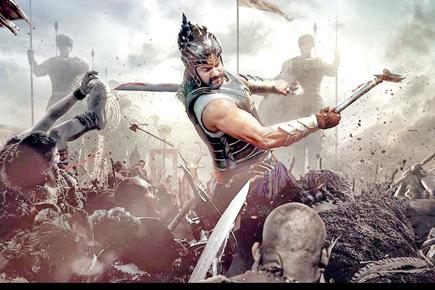The great tectonic plates of Bollywood and regional cinema are coming together rapidly

Baahubali
 The great tectonic plates of Bollywood and regional cinema are coming together rapidly. This is an excellent trend, as it will finally help India integrate into an all-India film market, instead of the highly splintered market we currently have, making films in up to 39 languages and dialects in a single nation — although that’s a unique and exceptional feat for any country. In recent times, there has been Baahubali, Bajrangi Bhaijaan, Raanjhana, Tanu Weds Manu Returns, Shamitabh and several others, that consolidate this North-South cinematic marriage, inviting talents from north and south of the Vindhyas.
The great tectonic plates of Bollywood and regional cinema are coming together rapidly. This is an excellent trend, as it will finally help India integrate into an all-India film market, instead of the highly splintered market we currently have, making films in up to 39 languages and dialects in a single nation — although that’s a unique and exceptional feat for any country. In recent times, there has been Baahubali, Bajrangi Bhaijaan, Raanjhana, Tanu Weds Manu Returns, Shamitabh and several others, that consolidate this North-South cinematic marriage, inviting talents from north and south of the Vindhyas.
ADVERTISEMENT
Look at both the behemoths that went head-to-head recently. SS Rajamouli's Telugu film Baahubali was presented by Bollywood’s Karan Johar. Originally made as a Telugu-Tamil bilingual, the film also released in Hindi and Malayalam versions. The film has earned over Rs 350 crore worldwide in just 10 days, according to The Indian Express. It is inspired by Pasivadi Pranam in Telugu, a Chiranjeevi starrer of 1987. Bajrangi Bhaijaan, Kabir Khan’s Salman Khan-starrer, has been produced by Salman Khan in collaboration with Rockline Venkatesh, a Bengaluru-based Kannada producer and actor.
 Prabhas in Baahubali
Prabhas in Baahubali
Moreover, its story has been written by writer-director KV Vijayendra Prasad, who also wrote Baahubali and is SS Rajamouli’s father. So Vijayendra Prasad did a double whammy, penning both the heavy hitters. Tamil superstar Dhanush toplined Bollywood’s Raanjhana and Shamitabh, and Madhavan was in Tanu Weds Manu Returns — all three films were produced by Bollywood biggie Eros — while Rana Dagubatti was in Dum Maaro Dum.
When Karan Johar presents a Telugu film in Hindi, it signals a big change in Bollywood’s outlook: an openness to crossing over in India through different languages — as Hollywood has long been doing in India, dubbing its English films into Hindi, Tamil and Telugu. Indeed, Vijay Singh, who heads Hollywood’s Fox Star Studios, once told the press that he estimates the Indian regional film industry is worth Rs 5,000 crore. Accordingly, Fox is making films in Tamil and Malayalam, and so are Disney, Eros and others.
Making multiple language versions of a single film, and collaborating with talents from different linguistic regions in order to deepen box office revenues, is an old tradition. For instance, V Shantaram remade his Kunku, originally made in Marathi in 1937, as Duniya Na Mane in Hindi the same year. The tradition continues in 2015, as Jeethu Joseph remade his own Drishyam (Malayalam) as Papanasam (Tamil), which has now been remade as Drishyam by Nishikant Kamat in Hindi. In Mani Ratnam’s latest film, the delightful O Kadal Kanmani in Tamil, his stars Dulquer Salmaan and Nithya Menon are both talented, and while of Malayali origin, have long starred in both Malayalam and Tamil films, additionally broadening the market base of the film.
Baahubali stunned Bollywood, which had assumed it was king of all-Indian cinema. It never really took those ‘Madrasis’ seriously. Baahubali also showed that a south Indian film, without a Bollywood star, can still be jaw dropping and bring in big bucks. SS Rajamouli has himself proved to be a Baahubali (the strong-shouldered one). The film raises the bar for Indian cinema in terms of tremendous visual panache. Rajamouli proves his directorial flair in the way he weaves the epic, the mythological, with special effects, yet with a futuristic, video game feel to it. To pull all this off in the same film coherently and convincingly, seamlessly weaving ancient past and exciting visual future, is a Herculean task. No Bollywood film even comes close.
Nor had any Bollywood film come close to full-on SFX of Shankar’s Enthiran (Robot), with Rajnikant and Aishwarya Rai, that fired on all eight cylinders and was fully paisa vasool. Enthiran in Tamil was Robo in its Telugu version and Robot in Hindi, and also beat Bollywood’s box office records in its time. But because the Bollywood press and critics don’t usually take note of films from other regions-as also happens during the National Film Awards — this was hardly noticed.
This week also brought the thrilling news that talented Tamil director Vetri Maaran’s Visaaranai (Interrogation) has been selected in the Venice Film Festival’s official selection, in the Orizzonti (Horizons) section for “the latest aesthetic and expressive trends in international cinema”. The film has been co-produced by Dhanush’s Wunderbar Films and Vetri Maaran’s Grassroot Film Company. It follows Chaitanya Tamhane’s brilliant Court in last year’s Venice Orizzonti, which was in Marathi, Hindi, English and Gujarati, and Adityavikram Sengupta’s Labour of Love in Venice Days, which had a Bengali milieu, but no dialogues.
That’s why it’s smart to make a ‘crossover film’ that crosses over within India, where the 1.2 billion market is, rather than only crossing over overseas. For a truly all-India audience, you would have to include all regions and B and C towns. The question To B or Not To B, is irrelevant.
Meenakshi Shedde is South Asia Consultant to the Berlin Film Festival, award-winning critic, curator to festivals worldwide and journalist.
Reach her at meenakshishedde@gmail.com.
 Subscribe today by clicking the link and stay updated with the latest news!" Click here!
Subscribe today by clicking the link and stay updated with the latest news!" Click here!






